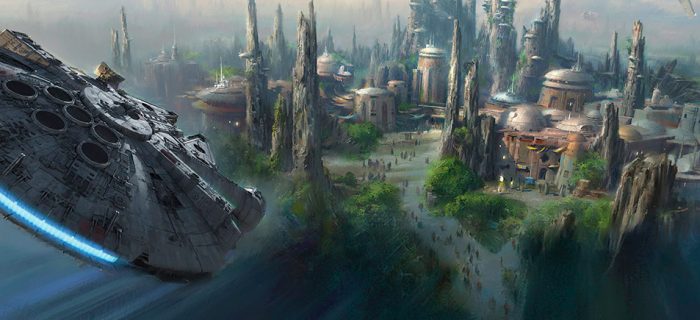
Star Wars: Galaxy’s Edge is still young at both Disneyland and Walt Disney World, but when it opened in the summer of 2019, it was one of the largest expansions the parks had seen in some time. Since it hasn’t even been open for two years (and the Disneyland location has been closed for over a year due to the COVID-19 pandemic), there are still millions who haven’t even stepped foot on the Outer Rim planet known as Batuu and the smuggler’s haven known as Black Spire Outpost. Thankfully, there’s a new book that can hold fans over.
The Art of Star Wars: Galaxy’s Edge by Amy Ratcliffe takes fans through the creation of the Disney theme park attraction, from the first concept art of the new canonical location in the Star Wars saga to ambitious ideas for attractions that never came to fruition. There’s even a sneak peek at what’s to come in the near future. Although the plethora of artwork is mesmerizing, it also raises many questions about how much more sprawling and epic Galaxy’s Edge could have been without providing many answers as to why some ideas were abandoned.
With a personal foreword from Scott Trowbridge of Walt Disney Imagineering and insights from various artists, designers, Lucasfilm executives and Disney Imagineers, The Art of Star Wars: Galaxy’s Edge reveals an ample amount of development and planning that went into creating the expansive theme park land. It’s not just a journey through determining what the theme park would look like, but it’s also a chronicle of how the many minds of Disney and Lucasfilm diligently worked to create an experience that was unique, immersive, and captured the spirit of Star Wars without simply resting on the laurels of the many iconic scenes that have unfolded across the saga since 1977.
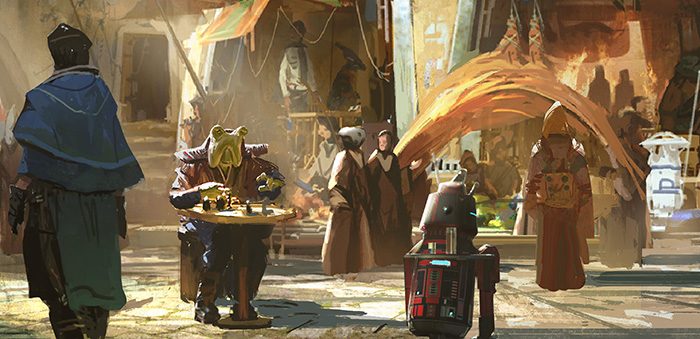
Since the this book is called The Art of Star Wars: Galaxy’s Edge, there’s not a substantial amount of insight into the creation of the park outside of the concept art. Instead it’s more broad strokes about how the Imagineers tried to authentically replicate the vibe of Star Wars while still creating something that felt completely new. This meant not only digging into the Lucasfilm archives to check out various props, models, costumes, and creatures from over the years, but also looking at other sources like 18th century Italian vedutisti artists, the petrified forests of Arizona, and many more locations around the world. But beyond a few interesting tidbits, most of what’s said in the book merely builds slightly upon what was already revealed during the park’s development and promotion.
As with the many artbooks that have been released for the Star Wars movies over the years, the many pieces of concept art are the biggest draw, and they’re more than satisfying. There are early pencil sketches, rich illustrations, and lush landscapes that look like they were created for a Star Wars movie that was never made. In fact, the creation of Galaxy’s Edge forced Disney Imagineers to figure out how to bring the Star Wars universe into the real world, which included some fascinating feats of engineering and a slew of improvisational touches that subtly and mostly unnoticeably venture away from the actual design elements of certain memorable pieces of the franchise.
One of the more interesting behind-the-scenes details comes from the making of the Millennium Falcon: Smuggler’s Run attraction. Disney Imagineers were forced to figure out how to turn the original kitbashed model of the iconic ship (meaning it was made from assorted pieces from a variety of model kits) into a life-sized staple within Galaxy’s Edge. That meant rethinking pieces that clearly came from automobile models. For example, the original Millennium Falcon model had dozen of tiny license plates with Earth-bound branding and logos glued onto it. So Disney’s designers adapted those little touches so they felt authentic to the Star Wars universe by adding aurabesh text and the same color schemes.
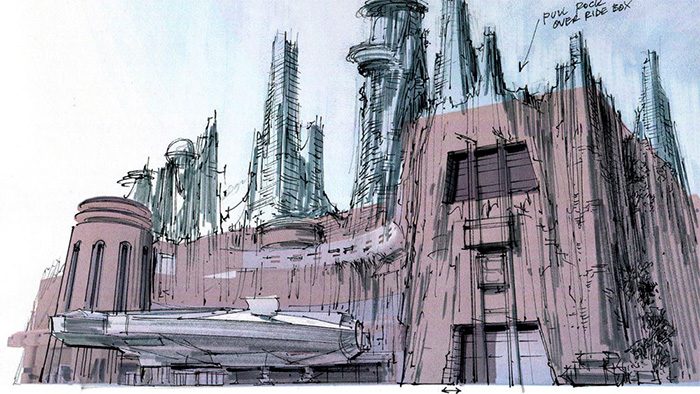
Because the revelations about the development of Star Wars: Galaxy’s Edge are so few and far between, a lot of the art raises more questions than answers, and the book could have benefited from more insight into the development process. For example, there are only fleeting glimpses and brief mentions of a fast-paced speeder bike chase attraction and a bounty hunter chase attraction. The unused attractions aren’t explored beyond a mere footnote accompanying the art, and there’s no explanation as to why they never made it to the park. And those aren’t the only interesting abandoned ideas that are featured in the book. There were also a handful of other areas that were either scaled back or considered far too ambitious and complex to pull off.
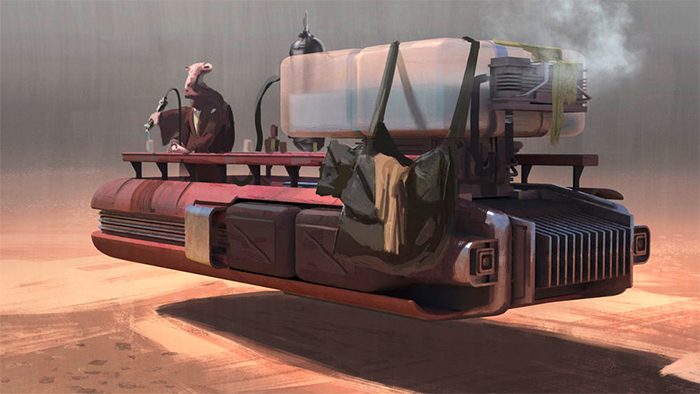
Other phenomenal pieces of artwork show off ambitious plans for the droid shop factory, which included a massive junkyard and foundry-inspire areas with huge containers of molten metal. There’s also art for an unmade area called The Stables that would have housed many of the creatures fans love from the Star Wars universe, from womprats and lothcats to wampas and rancors. But this, along with a giant interactive creature named Elee that fans could ride, proved to be too complicated for interaction with the high number of attendees expected in the park. Even the sale of blue milk and soft drinks was intended to be a little more interactive, with various “floating” carts and coolers traveling around the park to sell attendees refreshing beverages.
Artwork within the book also shows off a myriad of alien characters that would have required cast members to wear full-on prosthetic alien headpieces and wardrobes. Various alien bartenders were imagined for Oga’s Cantina, both as a character for a cast member to play and a potential animatronic. There was even an idea where the owner of the cantina was imagined to be one of a variety of massive creatures encased in a giant fishbowl at the center of the bar. But the limitations of technology, puppeteering, and resources in general kept it from becoming a reality.
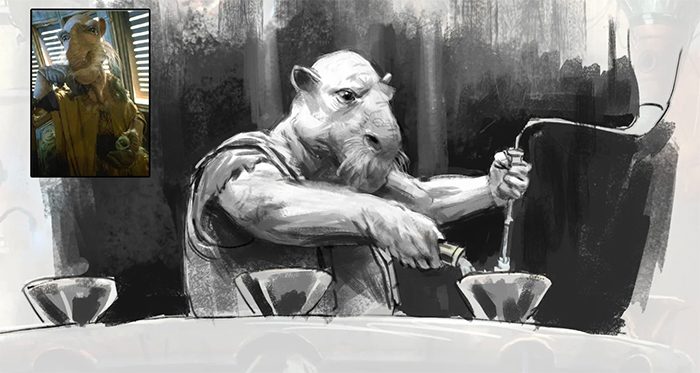
One of the more amazing axed concepts appears in the form of The Kalikori Club, which would have been a table service restaurant designed as a Twi’lek night club and spice den. Imagine the upscale touch of Canto Bight from The Last Jedi, the nightlife vibe of The Outlander Club from Attack of the Clones, and some industrial elements from Mos Eisley Cantina in A New Hope, and you have some frame of reference for what this place would have looked like. There was even a whole new cantina band designed for this place. The idea was abandoned when the story of Batuu shifted, and this restaurant/speakeasy didn’t quite fit with the rest of the plans.
To really see how much more grand Star Wars: Galaxy’s Edge could have been (and still can be), you need to flip through the pages of this book. That’s not to say Galaxy’s Edge hasn’t delivered an incredible way to experience the Star Wars galaxy, but it’s clear that there were many more ideas that could have filled out the land even more. Perhaps some of these ideas could be incorporated into future updates if Disney’s hopeful plans for and “immersive theme park expansion” get approved by Anaheim. There’s much more of this Star Wars locale that we’d love to explore, and the pages of The Art of Star Wars: Galaxy’s Edge show how much potential there is to make this theme park destination even better. That includes some new glimpses of art featuring the upcoming Star Wars Galactic Starcruiser resort at Disney World known as The Halcyon.
The Art of Star Wars: Galaxy’s Edge book is available today, and you can order it right here.
The post ‘The Art of Star Wars: Galaxy’s Edge’ Delivers a Smuggler’s Load of Amazing Art and Unanswered Questions appeared first on /Film.
0 Comments